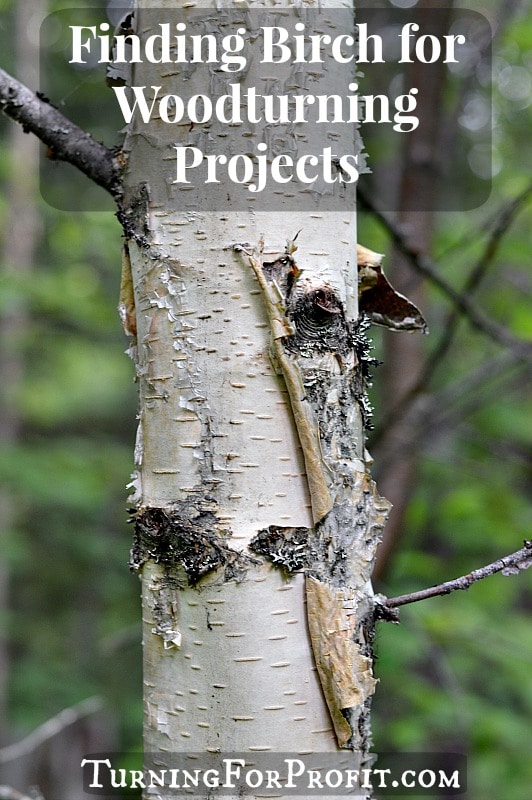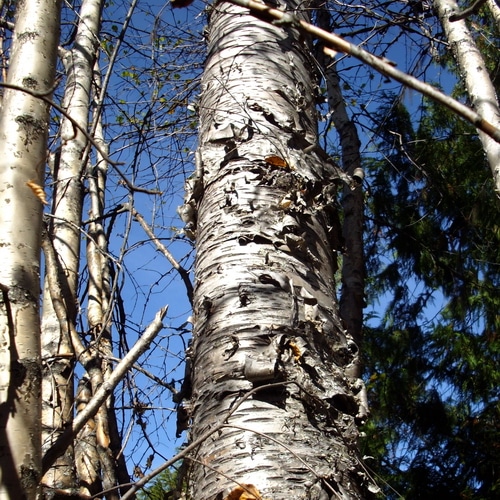If you’ve ever wondered if silver birch is good for woodturning, you’re in the right place! Woodturning is a fascinating craft that involves shaping wood into beautiful objects using a lathe. In this article, we’ll explore whether silver birch is a suitable wood for this craft. So, grab your tools and let’s dive in!
When it comes to woodturning, the choice of wood is crucial. Some woods are better suited for specific projects, offering unique characteristics that enhance the final result. Silver birch, with its distinct pale color and smooth texture, has gained popularity among woodturners. But is it really good for this craft? Let’s find out!
Before we can answer that question, let’s consider some important factors. The properties of a wood, such as its hardness, grain pattern, and workability, all play a role in determining its suitability for woodturning. So, join us as we explore the qualities of silver birch and discover if it’s the perfect wood for your next woodturning project. Let’s get started!

Is Silver Birch Good for Woodturning?
Welcome to our in-depth guide on whether silver birch is good for woodturning. Woodturning is a popular craft that involves transforming pieces of wood into beautiful and functional objects. Before you start your woodturning project, it’s important to consider the type of wood you’re using. In this article, we will explore the characteristics of silver birch, its suitability for woodturning, and some tips for working with this particular wood.
The Characteristics of Silver Birch for Woodturning
Silver birch, also known as Betula pendula, is a deciduous tree native to Europe and parts of Asia. It is known for its distinctive silver-white bark and delicate, feathery foliage. In terms of wood characteristics, silver birch is a medium-density hardwood, which makes it relatively easy to work with. It has a straight grain and a fine texture, giving it a smooth and uniform appearance.
One of the main advantages of silver birch for woodturning is its versatility. It is suitable for both beginner and experienced woodturners, as it is generally easy to shape and carve. The wood turns easily on the lathe and holds detail well, making it ideal for creating intricate designs and turning delicate forms such as bowls, vases, and spindle work.
Another notable characteristic of silver birch is its stability. It has good dimensional stability, meaning it is less prone to warping or splitting compared to other types of wood. This is important for woodturners, as it ensures that the final piece remains structurally sound and maintains its shape over time.
Benefits of Woodturning with Silver Birch
There are several benefits to using silver birch for your woodturning projects:
- Easy to work with: Silver birch is a forgiving wood that is suitable for woodturners of all skill levels. It is easy to shape, carve, and sand, making it a great choice for beginners.
- Attractive appearance: The light color and fine texture of silver birch wood give it a beautiful and elegant aesthetic. It can be left unfinished to showcase the natural beauty of the wood or easily stained or finished to achieve different looks.
- Stability: Silver birch has good dimensional stability, which means that it is less likely to warp or crack during the woodturning process or over time. This stability ensures a more durable and long-lasting final product.
- Versatility: Silver birch is suitable for a wide range of woodturning projects, from small decorative items to functional pieces like bowls and vases. Its ease of turning and ability to hold detail make it a versatile choice for various designs.
Tips for Woodturning with Silver Birch
When working with silver birch for woodturning, here are some tips to keep in mind:
- Use sharp tools: Silver birch is a relatively soft wood, but it can still benefit from sharp tools. Blunt tools can lead to tear-out or rough surfaces, so make sure to keep your tools sharpened properly before starting your project.
- Take care with the bark: The bark of silver birch is thin and prone to cracking. If you want to preserve the bark on your woodturning piece, take extra care while turning to minimize damage. Alternatively, you can remove the bark before turning for a cleaner and more uniform surface.
- Experiment with finishing: Silver birch can be finished in various ways to enhance its appearance. Consider experimenting with different finishes, such as oils, waxes, or stains, to achieve the desired look for your project.
Other Woods for Woodturning
While silver birch is a great choice for woodturning, there are other types of wood that you might also consider for your projects. Here are a few popular options:
Oak
Oak is a dense and durable hardwood that is known for its strength and attractive grain patterns. It is a versatile wood that can be turned into a variety of items, from furniture to decorative bowls.
Maple
Maple is a light-colored hardwood that is highly regarded in the woodworking world for its stability and fine grain. It is commonly used for turning bowls, spindle work, and furniture.
Cherry
Cherry wood has a rich reddish-brown color that deepens with age and exposure to light. It is a moderately hard wood that turns beautifully and is popular for creating decorative and functional pieces.
Conclusion
Silver birch is indeed a great choice for woodturning. Its ease of workability, attractive appearance, and stability make it a preferred wood for both beginners and experienced woodturners. When working with silver birch, remember to use sharp tools, handle the delicate bark carefully, and experiment with different finishing techniques. However, don’t limit yourself to just one type of wood—explore other options like oak, maple, and cherry to add variety and expand your woodworking possibilities. Happy turning!
Key Takeaways: Is Silver Birch Good for Woodturning?
- Silver birch is a popular wood choice for woodturning projects.
- It is known for its light color and fine grain, which makes it visually appealing.
- Silver birch is relatively soft, making it easy to work with using woodturning tools.
- It is suitable for making bowls, vases, and other decorative items.
- However, silver birch may not be as durable as some other hardwoods, so appropriate finish and care are important.
Frequently Asked Questions
When it comes to woodturning, one popular wood choice is silver birch. If you’re curious about whether silver birch is good for woodturning, check out these frequently asked questions:
Q: What makes silver birch a good wood for woodturning?
Silver birch is valued for its attractive light color and subtle grain patterns, making it visually appealing for woodturned projects. It is relatively easy to work with, as it has a fine texture and straight grain. This wood is known for its stability, which means it is less likely to warp or split during the turning process. Its moderate density allows for smooth cutting and shaping, making it popular among woodturners.
Additionally, silver birch is readily available in many regions, making it easily accessible for woodturners who want a reliable and affordable wood option. All these qualities contribute to silver birch being considered a good wood for woodturning.
Q: What are the limitations of using silver birch for woodturning?
While silver birch has many positive attributes for woodturning, it also has some limitations to consider. One of the main limitations is that silver birch can be prone to tear-out, especially when turning intricate or delicate designs. Careful planning and the use of sharp tools can minimize this issue.
Another limitation is that silver birch may have a tendency to fuzz or raise its grain during the turning process. This can be managed by using appropriate sanding techniques and finishes to achieve a smooth and polished final result. Despite these limitations, with proper techniques and precautions, silver birch can still be a great wood choice for woodturning projects.
Q: How should I prepare silver birch for woodturning?
Before turning silver birch, it is important to properly prepare the wood. Start by cutting the wood into manageable sizes and sealing the ends to prevent moisture loss. This helps to minimize the chances of the wood splitting or cracking. Let the sealed wood pieces dry in a controlled environment for several months until they reach a stable moisture content.
Once the wood is dry, it should be properly mounted on the lathe, ensuring it is securely held in place. It is recommended to wear appropriate safety gear, such as goggles and a face shield, when woodturning. Always follow proper safety procedures and techniques for woodturning to ensure a safe and enjoyable experience.
Q: What are some popular woodturned projects using silver birch?
Silver birch is versatile and can be transformed into a variety of woodturned projects. Some popular projects include bowls, vases, spindle work, and decorative items. The light color and fine texture of silver birch allow for intricate detailing and finishing techniques, giving woodturners the freedom to create unique and artistic pieces. Whether you’re a beginner or an experienced woodturner, silver birch can offer a range of possibilities for your projects.
Q: How should I finish silver birch after woodturning?
After completing the woodturning process with silver birch, it’s important to apply an appropriate finish to protect and enhance the wood. Begin by sanding the turned piece to a smooth surface, starting with coarse-grit sandpaper and gradually progressing to finer grits. This helps achieve a polished finish.
Once the surface is smooth, you can choose from a variety of finishes such as oils, waxes, or lacquers, depending on your desired outcome. Test the chosen finish on a small area before applying it to the entire piece to ensure it provides the desired look and feel. Applying multiple coats and buffing the surface between coats can further enhance the final result. With the right finishing techniques, you can bring out the natural beauty of silver birch in your woodturned creations.

Woodturning | Silver Birch Bowl
Summary
When it comes to woodturning, silver birch can be a good choice. Its smooth texture and attractive grain make it a popular option. However, it can be prone to splintering, so precautions should be taken. Overall, silver birch is a versatile and visually appealing wood for woodturning projects.
It’s important to note that different woods have different characteristics. While silver birch is suitable for woodturning, there are other options to explore. Don’t be afraid to experiment with different types of wood to find what works best for your projects. Happy woodturning!